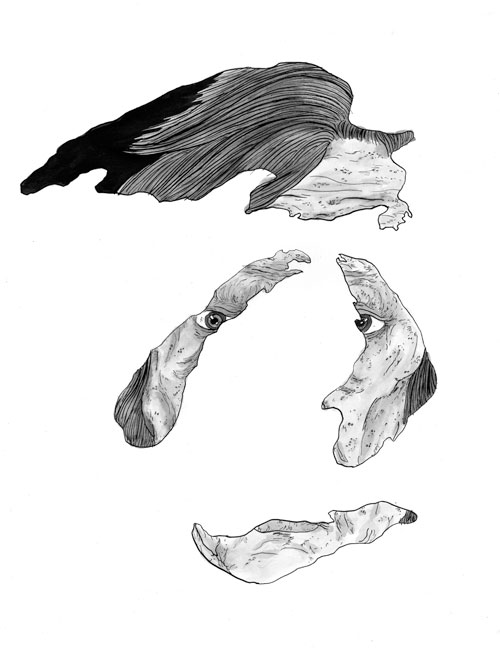Responses Takes

At first, I wanted to write a response that would be a pastiche of Mariev Finnegan, but I simply haven’t smoked enough “saliva.” One suspects that her fictional world is a little too complete (right down to the consistent linguistic errors), that it is not in fact a fictional world at all. Finnegan herself promotes this suspicion when she self-identifies in the by-line with the protagonist, as “Matriarch of the Erie.” The story comes from a place of extreme eccentricity, far out from the thick of things, and is utterly unapologetic. If the protagonist has a volatile disposition, teetering on what would traditionally pass for mental illness, then this becomes a dowel on which to hang stories of a marginal way of life in an economy of want. This is one kind of appeal “Welfare Fraud Lady” possesses: it’s a hilarious account of post-financial crisis survivalism. Another virtue of the piece is the protagonist’s frightening and endearing contrarianism, which becomes a way to meet Obijwe writer David Treuer’s challenge in a recent Slate magazine article to write about Native Americans without recourse to “Indian tragedies.” Finnegan’s startling crotchet—we can provisionally call it “insanity”—only functions because we have a resented baseline, a norm, against which its alter-rationalism can manifest. The relentlessness of her anti-reason, especially against the backdrop of our administered world, suggests authentic madness. It might not only be the characters in this story who are insane.
As Finnegan herself disappears behind attempts to capture and identify her, so too do bigger questions dissolve. I am not talking about the literary-critical question of authorship, obscure and uninteresting to anybody but a literary critic, but rather to the questions of personhood and would-be self-evident categories of human being. We live in a time when easily identified “identities” govern even discussions of internally heterogenous groups that are marked by border crossings or metamorphoses (immigrants, the transgender, victims of the new economy of precarity). Meanwhile, Finnegan grabs us by the shoulders and pushes us off a cliff, depriving us of the categorizing ground beneath our feet. Is this an act of violence and aggression? Yes.
In a post on the website “unexplained-mysteries.com,” Finnegan identifies herself as “Erie by birth and white by ancestry.” While this is hardly a straightforward or unequivocal statement of ethnic heritage, it becomes difficult to construe her as a Native American on the common (genealogical) understanding of the word. To be fair, the story clearly redefines the “Erie” as anti-identitarian; “Erie” here is no exclusive label, and thus one could argue that Finnegan is not misrepresenting herself. The story culminates with the breakdown of the WFL, who has unknowingly smoked “saliva,” and the great reveal is that she too is “Erie.” On my first reading, I took the designation as ambiguous, that the WFL could either have been ethnically Erie or have been Erie in the broader, oppositional sense, or both. Isn’t this flippant? Isn’t it unethical to appropriate a First Nations identity to the ends of some metaphor? Certainly. But there is more to this story, and it turns out that my first reading was naive.
In fact, the Erie as a nation have not existed since the 17th century when other Iroquoian tribes defeated them in armed conflict and absorbed their population. Any cursory knowledge of the Erie would immediately reveal a claim to factical Erie-ness as non-sensical. The reader unfamiliar with the situation of Native Americans in upstate New York—as I confess I was—is easily hoodwinked into thinking Finnegan really lived on such a thing as an “Erie reservation.” On a second reading, it is clear that Finnegan exploits typically superficial knowledge of the Native American situation to create a mirage category. The Matriarch of the Erie is even more of a trickster than she first appears. Just as she invents the “hardship waiver” that the WFL only later realizes is made up, she tricks the majority of the readership by fictionalizing an entire ethnic group.
“Welfare Fraud Lady” in the best of cases will have an effect on you like it had on me. You can’t help but hold contradictory feelings about it. On the one hand, even if Finnegan is patently not trying to insinuate herself into any Erie blood quantum rosters, her story still depends on the fixings of Native American-ness that is put-on, and this leaves me feeling uneasy. On the other hand, the Matriarch’s anarchical way of seeing the world has a strange guerrilla electricity to it. Not only disquieting and thought-provoking (and entertaining), the tack in this story is unique. The font of inspiration from which Finnegan draws, a species of narratively and politically clever insanity, is a rare and precious one. —Daniel Howell